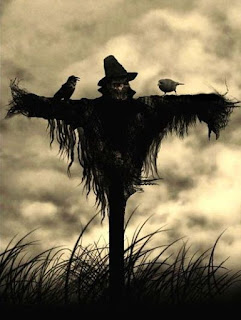by Patti Sherry-Crews
It’s that time of year when the colorful, round-faced, smiling scarecrows are everywhere. Decorating the neighbors’ porches. Maybe sitting on a bale of hay. In shop windows. Aren’t they cute?
I’ve been thinking a lot about pests this year because hordes of chipmunks, rabbits, raccoons, possums, and squirrels have been destroying both my vegetable and our newly planted pollinator gardens. Plenty of skunk too, who I don’t think are bothering my plants, but nonetheless, they're skunks. Everyday, looking out at my yard it looks like a scene from Bambi with all the happy critters cavorting in my garden. We’ve tried everything: coyote urine, chunks of a well-known pungent soap, chicken wire, and sprinkling cat and human hair around the plants. But every morning I wake up to the destruction of half-eaten tomatoes and flowers nibbled down to their roots.
I’ve been imagining what a failure my we'd make as homesteaders. I’ve been looking back to see what ways the old timers used to deter pests--scarecrows being one of them. Only not the cheerful kind we see around our neighborhoods.
Scarecrows, it turns out, have an interesting history. They emerged in the ancient world, Egypt, Japan, and Greece, at about the same time. And there was nothing cute about them.
The Greeks modeled their scarecrow on the son of Dionysus and Aphrodite, Priapus, who was said to be so ugly he scared birds. These wooden statues were painted purple and put in fields. Priapus had a club and a sickle in each hand and a large….you can look that one up yourself. His name is a clue to his other signature feature.
The Romans borrowed the Priapus scarecrow and spread it all over the Roman Empire extending into Europe.
Later in medieval Europe, it was the task of children to guard the fields and chase away pests. Sadly, the plague diminished the population to the point there weren’t enough bodies to patrol the fields, soooo, back to scarecrows. Old clothes stuffed with rags or straw with an animal skull or a gourd for a head, maybe stick some putrid meat in there for that olfactory defense.
Native Americans also needing to protect their crops, used both human guards and scarecrows. Zuni children held contests to see who could make the scariest scarecrow.
European immigrants to America brought their tradition of scarecrows, though they were called different names by different cultures. For instance, in Germany they are called Bootzamon, which later became the Bogyman.
There was a time when the American landscape was dotted with scarecrows. Then they disappeared in a puff of DDT. After DDT was found to be harmful, farmers developed new, higher tech ways to scare off pests, and scarecrows were regulated to a peaceful retirement as holiday decorations.
In many farming cultures around the world, it was traditional to burn the scarecrow at the end of harvest and return it to the earth. That is why scarecrows, like snowmen, are classified as “ephemerals”--creations not meant to spend much time on earth.
As old as scarecrows themselves, are the stories of them coming to life. For instance, a Japanese story in the year 712 features a scarecrow, Kuebiko, who can’t walk but knows everything. And arguably the most famous animated scarecrow, is the scarecrow from the Wizard of Oz. He only wanted a brain, and discovered he had wisdom after all.
There’s something about a scarecrow.
And to get everyone in the spirit of Halloween, fellow Cowboy Kisses author, Andrea Downing, and I have put together a scary twofer for you. Two novellas from a collection of stories connected by a paranormal detective agency set in the old west for only $0.99!
About From the Files of Nat Tremayne:
In The Ghost and The Bridegroom, P.S.I. Agent Healy Harrison is sent to Tucson to rid a rancher of the ghost in the bedroom interfering with his marriage to a mail-order bride. Healy doesn’t think she’s destined for romance—until she meets Pinkerton detective Aaron Turrell. But when their two cases dovetail, will their newfound love survive the ultimate showdown the between mortal and immortal.
In Long A Ghost and Far Away, agent Dudley Worksop aims to unravel the mystery of Colby Gates’ dead wife. Lizzie not only seems to have reappeared as a ghost, but has time traveled from 2016 to the 1800s. Can revenge be had for her murder? And can the couple be reunited across country and across time?
These stories originally appeared in The Good, The Bad, and The Ghostly.




4 comments:
Wow, who knew? I can just see that Priapus striking a pose with a bird perched on his priapic organ. Am I allowed to say that here? As for your garden troubles, I see no mention of mint oil. I recommend that highly--they hate the smell. Must be pure and undiluted and sprinkled around. I promise results. Great post, Patti--thanks for an eye-opener.
Very interesting, Patti, since I love scarecrows. Thank you for sharing!
Thanks, Julie! I may be adding a scarecrow to my yard soon! Andrea, I do have peppermint oil which I bought for my indoor pest problem. It did nothing for those guys and I'm afraid I had to go to more murderous extremes. I will try it outdoors though. I made a spray with cayenne pepper and dish soap, which seems to have helped, but yesterday I made a stronger solution with habanero peppers. Because the habanero peppers are the one thing left unmolested in the garden. I'll let you know how that goes!
Goood reading
Post a Comment